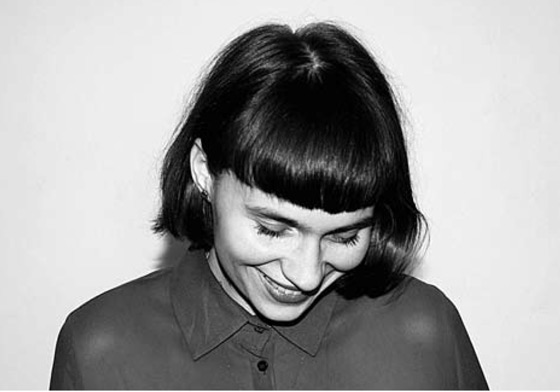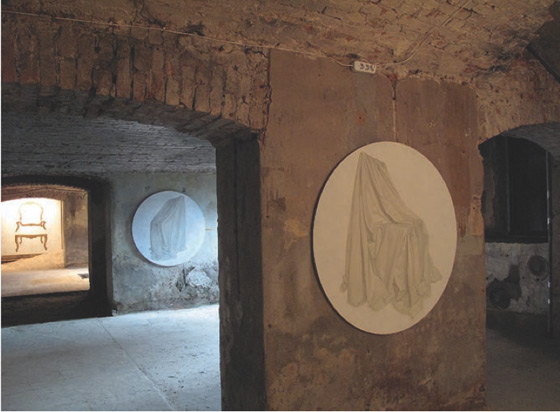|
|
| With “the bony one” breathing down one’s neck Sniedze Sofija Kāle, Art Historian Krista Dzudzilo. Neuter 05.06.–19.06.2013. Rīga, Merķeļa iela 19 | |
| Having by now taken active part in a number of group exhibitions in Latvia as well as three abroad, and also as the recipient of the Boris Bērziņš scholarship in 2010, the name of the young painter Krista Dzudzilo (born 1989) already seems familiar. Therefore it was somewhat surprising that her recent solo exhibition Neuter turned out to be her bachelor’s degree work. Similarly as her first solo show Tukšā telpa (‘Empty space’) took place at the Kaņepe Culture Centre, this also was exhibited in a purposely selected space – the basement of a building at Merķeļa iela 19. The influence of the surroundings on the viewer and the inter- play between them is considered to be a priority because in parallel with painting, the artist is involved in theatre and stage design. Together with her partner Reinis Dzudzilo, she has worked on number of theatre projects (Raudupiete at Valmiera Drama Theatre, Purva bridējs and Izrāde gals at the Latvian National Theatre, Indrāni at the Mikhail Chekhov Riga Russian Theatre, Hedda Gabler at Andre- josta, Kucēni at Dirty Deal Teatro). One of the couple works on stage set design and the other is responsible for costumes, thus creating a harmonious symbiosis, meanwhile manipulation of the audience’s perceptions with the conceptualization of space and by focussing attention on key elements with the aid of a spotlight becomes lodged in the blood. | |
 Krista Dzudzilo. 2013 Photo from the private archive of Krista Dzudzilo | |
| Even though in the basement of Merķeļa iela 19 there are more rooms than parts to the exhibition, it still managed to retain the sense of being in three sections, as intended. Like the Acropolis in Athens, the project Neuter revealed itself gradually and deliberately: at the beginning there were some mysterious draped chairs, as you moved on further into the space they lost their veils and the view opened to antique, refined yet worn seats (the idea of wrecks or empty carcasses as mentioned in the explanatory notes was not evinced). Some distance way away from these two series there was the most inti- mate of the three sections: the portrait of a woman (grandmother) in fragments of documentary photographs on canvas. All the paintings mentioned were characterised by a laconic, spare depiction, with only the most essential remaining. This formed an effective contrast to the damp, picturesquely crusty and weeping walls. The renunciation of a background, with the painted objects portrayed against a single colour base, is usual practice at the Art Academy of Latvia; it not only indicates a wish to avoid the direct transfer of reality, but often also reveals an easily carried out technique and the artist’s inability to conceptualise and articulate their position right to the very end, instead leaving it open and replacing it with dots. Given the artist’s experience of working in the theatre, as already mentioned, most likely the urge to divest all that is superfluous from the objects encountered in real life stems from a wish to show more clearly their symbolic meaning – death and the daily “small” deaths caused by abandonment and loneliness. The painted chairs in the exhibition Neuter speak of the absence of people or bear witness to the presence of people over a period of several decades, their sitting leaving unevenness in the springs and lumps in the upholstery. In the culture of the Japanese, the beauty of worn things is appreciated and given the name of sabi, a particular criterion of beauty that conveys the message that even a mortal can leave their traces on eternity. The mannerliness of the chairs chosen by the artist was somewhat puzzling, and reminiscent more of stage props than domestic life. The neoclassical style furniture pretentiously aspires to be historic and antique, but, taking into account Latvia’s past situation where revolutions and wars have been endured, the seats depicted did not carry associations of being part of an everyday interior which should bear testimony to the lives of a feminine weakness – the desire for aesthetic objects, revealing also a decorative function of painting which the artist herself does not deny as being an essential component of the medium. | |
 Krista Dzudzilo. View from the exhibition Neuter. 2013 Publicity photos Courtesy of the artist | |
| The manipulations of documentary photo fragments in the paintings shown in the third section, on the other hand, where only parts were disclosed – silhouettes of a woman, the frame of photo paper or the writing on the other side, caused confusion to the ap- parently certain trust that reproducible reality can be relied upon. Leading to the question: when a person that has passed away has been fixed in a concrete situation, what remains outside the frame? Does a photograph contain something more than the physical like- ness of the departed? How representative – or, on the contrary, treacherously shallow is the image in comparison to the importance of the departed in the perceptions of the bereaved? In contrary to the restrained objectivity chosen by Krista Dzudzilo, the recent ex- hibition Album of Loss by the Spanish photographer Mariano Icaza at the Latvian Museum of Photography demonstrated the therapeutic qualities of photography, when through the repetition of situations fixed in film a ritual of the revival of the departed and alleviation of pain was played out. In agreement with the artist’s statement in the annotation to the exhibition, from one aspect it can be admitted that the covered chairs speak of abandonment, become strange and transform the familiar into an alien object (similarly as has been done in an urban environment by Christo and JeanneClaude), but on the other hand they incorporate something so banal as one of the usual exercises for painting students: drapery studies. It is all too clear, also, that a chair – like a spoon that is given as a gift at a christening, or “is put down never to be picked up again” – is symbolic of the passage of a lifetime, or a confirmation of absence, however, be that as it may, at the same time it a prosaic everyday item which “happened to be” in the artist’s workshop. If we wish to remember the departed, then most often a photo album will be hauled out to refresh or enlighten the memory, in order to place personally fragile feelings in opposition to the seemingly objective. Of course, it isn’t really possible to speak objectively of death, in a way that it doesn’t lapse into banality – in the format of the empty and cliched skull image of pop culture. Death strikes harshly and directly, this was most clearly revealed in the text accompanying the exhibition written by the artist. Without shying away from open- ness, she admits that since childhood she has experienced “small death” or migraine attacks, when nothing on earth can lessen the terrifying sensation of paralysis and doom. The sense of impermanence that has been present since childhood has formed a perspective that, in the exhibition Neuter, cements apparently unconnected and as if often seen things into one integral whole. Quite possibly, if there was no conceptual underpinning to the exhibition and a revelatory text, it would have lost a part of its charm, because the ideas of visual rep- resentation, as we know, “fly in the air” and noone is protected from direct / indirect or unconscious influences (for example, a recent parallel – Krišs Salmanis’ upturned tree in the Latvian exposition at the 55th Venice Biennale and the 2010 installation Forest by German artist Michael Sailstorfer), but an artist’s world view is impossible to fake or to copy, and that does convince – despite the visual déjà vu. In the case of Krista Dzudzilo, the reflection based on experience that “after the death of people close to us, objects take on another meaning, another gravity – they become a reality in which nearness and presence remain” was the prevailing feeling of the exhibition Neuter, and the cool restraint in its implementation played it out in a tactful, wellstaged emotional experience (with two threedimen- sional accents – a table and a golden heap of sand), and stealthily led us away from the generalized towards the private. Translator into English: Terēze Svilane | |
| go back | |







